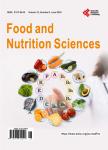Phenolic Compounds and Antioxidant Capacity of Brazilian Apples
Phenolic Compounds and Antioxidant Capacity of Brazilian Apples作者机构:Department of Food Engineering State University of Ponta Grossa Uvaranas Campus Ponta Grossa Brazil Post Graduate Program in Food Engineering Federal University of Paraná Polytechnic Campus Curitiba Brazil
出 版 物:《Food and Nutrition Sciences》 (食品与营养科学(英文))
年 卷 期:2015年第6卷第8期
页 面:727-735页
学科分类:1002[医学-临床医学] 100214[医学-肿瘤学] 10[医学]
主 题:Malus sp. FRAP Phenols Antioxidant Activity Multivariate Analysis
摘 要:Apple consumption is related to the prevention of chronic diseases due to the presence of phenolic acids and flavonoids that have antioxidant capacity. However, phenolic profile and antioxidant capacity can vary between varieties. The aim of this study was to analyze the total phenolic content (TPC) and antioxidant capacity (AC) of thirty-six apple varieties to establish a classification of these fruits. The TPC was analyzed according to the Folin-Ciocalteau method and AC was analyzed using the ferric reducing antioxidant power (FRAP) method. Hierarchical cluster analysis was used for the classification of the fruit. The TPC ranged from 456 to 1583 mg/kg of fresh fruit (catechin equivalents) and the AC ranged from 5606 to 23,719 mmol/kg (fresh fruit). The Pearson linear correlation showed significant differences in the association between TPC and AC (r: 0.79, p 0.001). The apples were classified into the following five groups according to their AC: very high (8%), high (17%), medium (47%), low (11%) and very low (17%). The varieties classified in the group with very high AC were Carícia, Mollies and Imperatriz. The Gala varieties showed a great variability in AC, with values classified as high and low, while the Fuji, with less variability, was classified as low AC. The classification of apples based on TPC and AC using hierarchical cluster analysis was performed and the results can be of great value to geneticists, producers and consumers.



